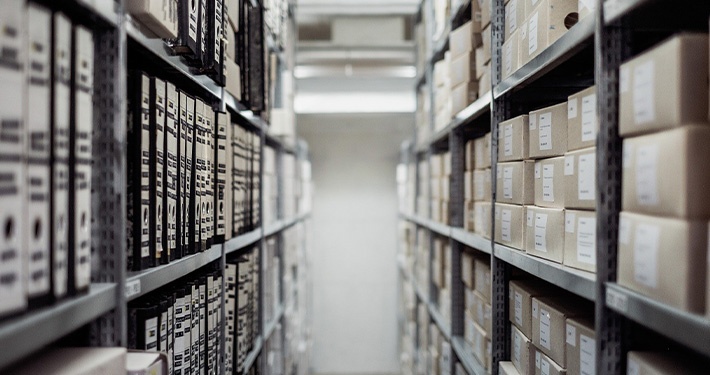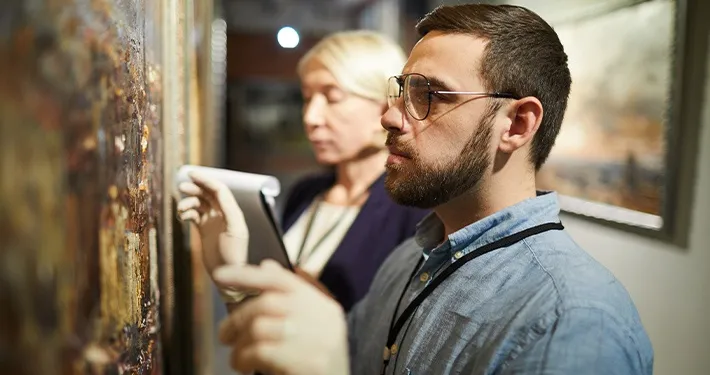

INTERESTING FACTS ABOUT MUSEUM STORAGE FACILITIES
19 Nov 2020
INTERESTING FACTS ABOUT MUSEUM STORAGE FACILITIES
Less than 10% of museum artworks are on display at any given time. Would you like to know why and see some statistics? Would you like to visit museum storage facilities? You will be surprised by the insights into global museum storage facilites.
A study conducted by Quartz based on data from 20 museums in 7 countries summarizes the current situation: Most works of popular impressionist masters like Paul Cézanne and Claude Monet are usually on display in museums. Also Pablo Picasso is mostly on display and not in storage.

FAMOUS AND HIDDEN ARTWORKS
Museums do own so many artworks that even artworks by Mark Rothko, Jeff Koons, Egon Schiele or Georgia O‘Keeffe are mostly in storage. Results from other surveys with structured methodology point out names such as Ed Ruscha, Joan Miró, Anish Kapoor or Anselm Kiefer with a lot of artworks in huge museum warehouses.
If you talk to museum curators and exhibition experts about which percentage of a museum collection is usually on display at any given time, you will get single digit percentage numbers between 3% and 7%.
Exceptions to the rule are Museums like the Tate with 20% or the Whitney Museum with 10%. However, the other side are the Berlinische Galerie with only 2% or the Albertina with less than 1% on public display.
Museums do own so many artworks that even artworks by Mark Rothko, Jeff Koons, Egon Schiele or Georgia O‘Keeffe are mostly in storage. Results from other surveys with structured methodology point out names such as Ed Ruscha, Joan Miró, Anish Kapoor or Anselm Kiefer with a lot of artworks in huge museum warehouses.
If you talk to museum curators and exhibition experts about which percentage of a museum collection is usually on display at any given time, you will get single digit percentage numbers between 3% and 7%.
Exceptions to the rule are Museums like the Tate with 20% or the Whitney Museum with 10%. However, the other side are the Berlinische Galerie with only 2% or the Albertina with less than 1% on public display.
© Ula Kuzma
DID YOU EVER VISIT A MUSEUM STORAGE BUILDING?
Museums that open their storage facilities to the public
The Hermitage
The Brooklyn Museum of Art
The Smithsonian American Art Museum
The Museum aan de Stroom
The Louvre-Lens
The Metropolitan Museum of Art
The Brooklyn Museum of Art
The Smithsonian American Art Museum
The Museum aan de Stroom
The Louvre-Lens
The Metropolitan Museum of Art
Museums that have inspired others to open their storage rooms in the next years
The Boijmans van Beuningen Museum
The Victoria and Albert Museum
The Metropolitan Museum of Art
The Victoria and Albert Museum
The Metropolitan Museum of Art
WHY DO MUSEUMS HIDE MOST ARTWORKS?
Curators would often like to show more, but often the main problem is space. Many artworks stay in crates for many years without being sorted, e.g. because of damage risk (some artworks require intensive care that can only be provided in a storage facility) or simply because of the high number of artworks waiting to be sorted by staff. Changing exhibition trends or lack of public interest are among other reasons. A new curator often means a new curatorial mission with a different approach to the museum exhibition or new rotation rules.
Curators would often like to show more, but often the main problem is space. Many artworks stay in crates for many years without being sorted, e.g. because of damage risk (some artworks require intensive care that can only be provided in a storage facility) or simply because of the high number of artworks waiting to be sorted by staff. Changing exhibition trends or lack of public interest are among other reasons. A new curator often means a new curatorial mission with a different approach to the museum exhibition or new rotation rules.

ARTOUI Materials
Exclusive Materials. Variety of surfaces beyond the Gallery Standard.
Share this article
Categories
Featured posts

FINE ART PRICING – 23 PRICE DRIVERS FOR ARTWORKS
16 Jan 2021

WHAT IS 1 MINUTE ART?
08 Feb 2020

Thomas Guggemos | Surrealist Painter
01 Nov 2020
You might be interested